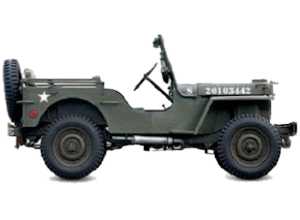In 1938, with war clouds gathering over Europe, the US Army decided to replace its motorized motorcycle-sidecar combinations (used for messenger and advance reconnaissance duties) with a small, general-purpose vehicle.

Willys MB Jeep 1942
- YEAR REVEALED 1942
- PLACE OF ORIGIN Toledo, Ohio
- HISTORICAL STATUS production car
- ENGINE four-cylinder, 134ci (2,199cc)
- MAXIMUM POWER 60bhp
- LAYOUT front-mounted engine driving all four wheels
- BODYWORK four-seater utility
- TOP SPEED 60mph (97kph)
- NUMBER BUILT 363,000 (plus 280,000 made by licensee Ford, and 2,675 by Bantam)
It let American motor manufacturers know its requirements in 1940, and three companies responded with prototype vehicles-Willys Overland’s Quad, the American Bantam Car Co.’s Blitz Buggy, and the Ford Motor Company’s GP. After a protracted and complex bidding process, Willys’s concept for a light 2,106lb (955kg), maneuverable, and powerful all-purpose vehicle, capable of carrying troops as well as weapons, was selected for production.
It boasted selectable two-or four-wheel drive-a true breakthrough. It went on to serve in every major World War II campaign as a machine-gun firing mount, reconnaissance vehicle, pick-up truck, frontline limousine, ammunition bearer, wire-layer, and taxi. In the Ardennes during the 1944-45 Battle of the Bulge, Jeeps loaded with stretchers, raced to safety ahead of spearheading Nazi armor.
In Egypt, Britain used a combat patrol of Jeeps to knock out a fleet of fuel tankers en route to German Field Marshal Rommel’s armour forces on the eve of the battle of El Alamein. “Jeep” soon became a household word, many assuming it was a slurring of the acronym GP, for General Purpose. Willys offered civilian editions from 1945, and the Jeep name was registered as an international trademark five years later.